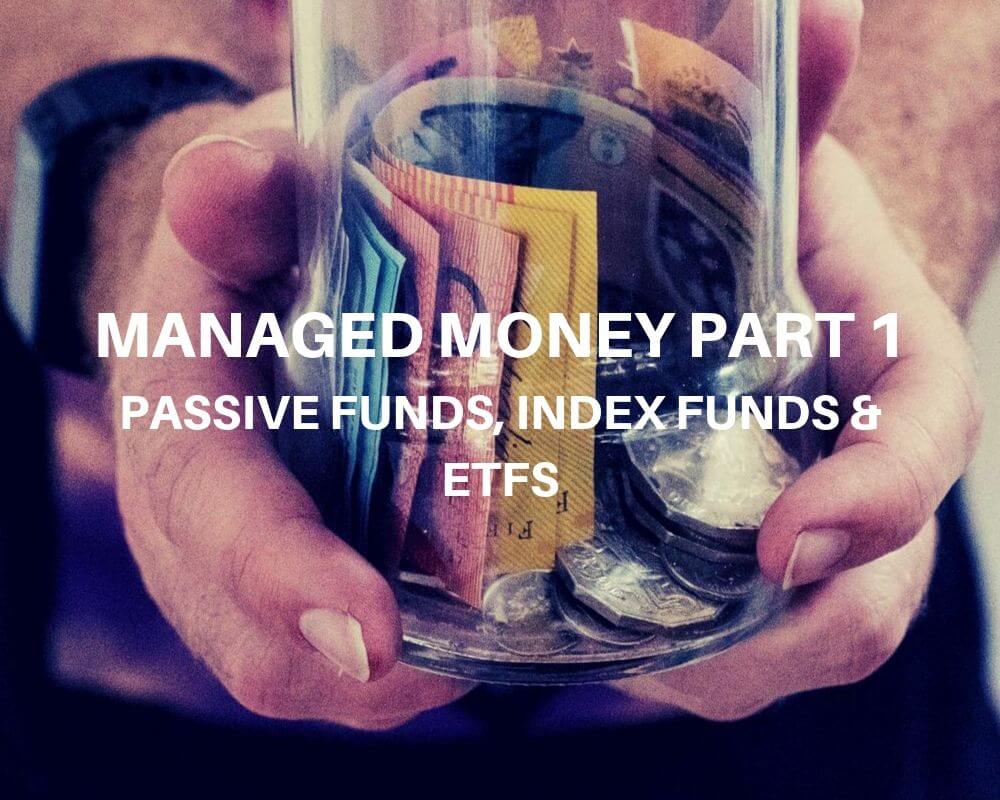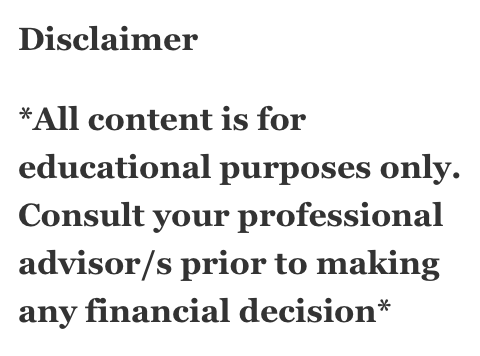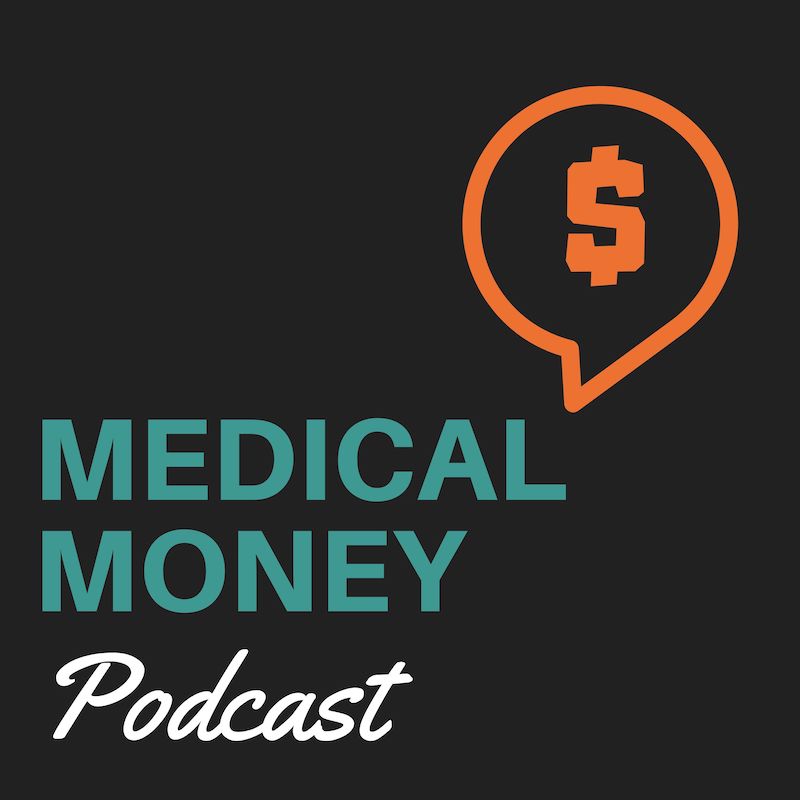
Index investing is a long-term passive investing strategy that allows you to capitalise on the long term growth of the share market in a low fee environment.
Since the Global Financial Crisis in 2008, there has been an index investing revolution. Index investing is so popular that in the US, 45% of funds are passively invested in index funds or index ETFs (exchange traded funds)
This is the first of 2 posts on managed money. The second is on listed investment companies and can be found here.
In this post we will discuss:
- what is an index
- what are index funds
- what are ETFs
- the costs for investing in each
This page may contain affiliate links which might pay me a commission. I may also hold positions in the investments discussed. Please read my disclaimer for more info.
What Are Shares?
Shares, or stocks, are one of the core asset classes.
In Australia, we tend to use the term shares, in the US they prefer to call them stocks. I’ll use both interchangeably in this piece.
A share represents a small piece of a company. Public companies are listed on a regulated public stock exchange like the Australian Stock Exchange (ASX). The exchange allows investors to buy and sell their shares.
There are two ways to make money from shares. First is by receiving dividends that the company pays out from its earnings. The second is by selling your shares for a capital gain when another investor is willing to pay you more for the shares than your original purchase price.
What Is An Index?
An index is a hypothetical basket of assets. As an example, lets use an index close to home .
The ASX200 is an index that represents a basket of the 200 biggest companies on the Australian Stock Exchange. These companies represent 80-85% of the value of the entire Australian Stock Market.
The ASX200 was started on March 31,
Each company in the index is given a weighting based its market capitalisation (market cap). In mid-2019 the largest company is Commonwealth Bank which is valued at nearly $150 billion and comprises 7.4% of the ASX200. At the bottom end, Speedcast International is worth around $300 million and represents 0.1% of the index.
View the weightings of the ASX200 companies and read about how the index is constructed.
The value of the index fluctuates with the current share price of the companies in the index. Because the index is “
The index allows us to to do number of things.
Firstly, it allows us to track the performance of the overall stock market across time- you will commonly see the ASX200 quoted on the evening news. A move from 6,000 to 6,600 indicates a 10% weighted increase in market value.
Secondly, it allows us to compare the performance of other investments against the index. It must be noted that as the ASX200 is rebalanced quarterly and it has a survivor bias- companies that shrink in market cap or go out of business fall out of the index.
Other commonly quote indexes include:
All Ordinaries- Australia’s biggest 500 companies which
S&P 500- 500 of the biggest US companies chosen by the Standard & Poor’s selection committee.
Dow Jones Industrial Average-30 of the biggest US companies

The Beginning of Managed Money
From the beginning, ordinary investors have invested in shares by buying them directly through a stock broker. They either took the time to analyse companies themselves or acted on the advice of their stock broker- who received a handsome commission for the recommendation. You can see this in action in the movies “Wall Street” and “The Wolf of Wall Street”.
Investment companies realised they could make huge guaranteed profits from investors and created managed funds or mutual funds. The modern-day managed fund was first created in 1924. The idea is that instead of directly buying shares, investors could pour their money into the hands of a master stock picker called a fund manager.
The fund manager would do all the research, visit company headquarters and dine with the CEOs. If they believed in the future prospects of the company, they invested some of the fund’s money. The costs of hiring the fund manager, travel expenses and fine dining were passed on to the investor in the form of hefty management fees. Another big cost passed on to investors were the kickbacks and referral commissions that funds paid to stock brokers and financial planners for recommending clients to invest money in the fund.
The cost of investing in a fund is called the Management Expense Ratio (MER
How do fund managers perform? How do you measure the performance of a fund manager?
Is it simply good enough that your fund manager makes you money after deducting their hefty fees?
We can compare a fund’s performance against:
- stashing money under the bed or in a savings account
- the rate of inflation
- the return of other funds
- relative to an index
Funds typically measure their performance against a benchmark index that matches the investment philosophy of the fund.
Unfortunately for investors, the majority of fund managers underperformed their benchmark index over time. What’s more, their fees ate up precious investor capital leaving less money to compound over time. Fees were typically upward of 1% of assets with additional performance bonuses for beating
Of course, there have been some star performers like Peter Lynch who annualised a 29% return in his Magellan Fund. But the reality was, and still is, that the majority of fund managers underperform the index over an extended period.
Last year 87% of fund managers underperformed the ASX200.

Index Investing 1.0 – Traditional Index Funds
“Don’t look for the needle in the haystack. Just buy the haystack.”
John Bogle, Vanguard
So now we have established there are two big issues to consider when investing in a fund:
- Fees
- Performance
The late John Bogle,
He created the first index fund on December 31, 1975 to the ridicule of his investment peers. It was called the First Investment Fund and tracked the S&P500. The fund began with $11 million.
The premise is that over the long term, investing in a broad-based index allows investors to capture a very good return. The S&P 500 has returned about 10% since its inception in 1926. So rather than paying fees to a fund manager to cherry pick individual stocks, his fund bought shares in every company in the S&P500 relative to its index weight.
By buying shares in only the biggest 500 biggest US companies, investors got diversification and could reap the benefits of a rising market over time. The performance of the index fund tracked the performance of the S&P500 minus fees and taxes.
By removing the need for management to travel across the country, stay in expensive hotels and drink fancy wine with CEOs, the fees only needed to cover the cost of brokerage and administration. With a MER significantly lower than the available managed funds, Bogle allowed investors to keep and compound more of their money.
Now four decades, we live in an index investing revolution. Nearly 50% of all funds invested in the US stock market are from indexed investments and all us has money in index funds, if not directly, then via our retirement/ superannuation accounts.
Traditional Index investing is a long-term, buy and hold strategy that invests in a broad-market index. Funds are not meant to be traded.
The key benefits of index investing are:
Diversification- by buying a range of stocks in a range of industries, there is less risk placed on fluctuations of a single company.
Low Fees- the management expense ratios (MER) are just a fraction of actively managed funds. Typically under $1 per $
Additional investments- easily add funds periodically and take advantage of dollar-cost averaging.
How to Invest In An Australian Index Fund
The two biggest companies with Traditional Index Funds for Australian shares are Vanguard and BlackRock. They each differ slightly in their benchmark index.
When buying an index fund you are purchasing a unit in the fund which has a dollar value. Each unit represents an equal share in the fund’s assets. The unit price fluctuates with the value of the fund’s asset under management (AUM). The funds are “open-ended” where more units are created as additional money enters the fund.
You are investing directly with the investment company and are required to complete their mandatory paperwork.
There are two fees. The first is a “spread” which is a transaction fee on entry and exit. The second is an annual management fee which is a percentage of the money you have invested in the fund.
Funds have minimum amounts for the initial investment and additional future investments.
Vanguard’s Australian Shares Index Fund
Vanguard has an index fund that tracks the return of ASX300 by investing in the biggest 300 Australian companies.
There are 2 options for their Australian Shares Index Fund
Retail
- minimum investment $5,000.
- spread 0.06%
- management fee 0.75% for investments <$50,000, reduced to 0.35% for >$100,000.
- minimum additional investment- not stated
- see the fund summary
Wholesale
- minimum investment- $500,000,
- spread- 0.06% ,
- management fee- 0.16%.
- minimum additional investment- $5,000
- See the fund summary
BlackRock’s iShares Australian Equity Index Fund
This fund tracks the performance of the ASX300 Accumulation Index. The accumulation index differs slightly from the ASX300 because it include the value of dividends in its calculations.
This is a wholesale fund:
- minimum investment- $500,000 (I’ve heard you can negotiate this down to $100,000 if you ask nicely)
- spread- nil
- management fee- 0.2%
- minimum additional investment- no minimum
- see the fund summary here.
Both companies allow investors to have funds deducted regularly from your account to be invested.
Index investing 2.0 – Exchange Traded Funds (ETFs)
Index Funds are investments made between an investment company (eg Vanguard) and the investor (eg you). The success of Index Investing prompted index funds to list on the stock exchange. This move allowed institutional investors to execute sophisticated trading strategies as they could buy and sell the index funds like shares. Each ETF is given a ticker code just a listed company.
The first ETF was created in 1990 in Canada and the first US ETF was listed in 1993.
Initially ETFs were just like traditional index funds- passive, broad-based and cap weighted. But as their popularity grew a new breed of alternative ETFs have entered the market. ETFs for sectors, bonds, commodities, real estate and currencies became available and some now behave more like a listed managed fund with higher MERs.
How to Invest In Index ETFs
ETFs are a unit trust with the fund manager acting as trustee of the funds. Each unit is an entitlement to a proportion of the fund’s assets.
There are currently about 250 ETFs listed in Australia with $55 billion invested.
The units can be purchased on the stock market like a share, but unlike shares in companies, ETFs are “open ended”. Just like index funds extra units are created when as funds are invested. Despite this, the units are traded (bought and sold) between investors not the investment company eg Vanguard.
The value of the fund is described by the Net Asset Value (NAV) per unit. The NAV is calculated throughout the day and units are traded very close to the NAV.
When buying or selling ETFs, instead of a spread, investors pay a brokerage fee and slippage. The slippage is the price difference between the offer price and the NAV. In large
As ETFs are bought and sold just like shares, through a stock broking service such as Commsec or Self Wealth. Unlike index funds, you do not need to do compliance paperwork with the investment company prior to your first investment.
ETFs also allow investors to invest in smaller dollar amounts. Rather than having to dump in a half a million dollars, theoretically you could buy a single unit though brokerage fees would eat a large proportion of your capital.
Because ETFs are trust structures, they are not able to retain earnings so dividends and profits are fully distributed.
Australian Index ETFs
Three Popular Australian Share ETFs in order of management fees.
BetaShares Australia 200 ETF
Since listing A200 has seen huge fund inflows due to its low management fees
- benchmark index- ASX200
- ticker code- A200
- mangement fee- 0.07%
- inception date- May, 2018
- see the fund summary
BlackRock’s iShares Core S&P/ASX 200 ETF
- benchmark index- ASX200 Accumulation index
- ticker code- IOZ
mangement fee- 0.09%- inception date- 6
December, 2010 - see the fund summary
Vanguard Australian Shares Index ETF
- benchmark index- ASX300
- ticker code- VAS
- mangement fee- 0.1%
- inception date- May, 2009
- see the fund summary
While there are over 2,200 listed companies in Australia, with a value of $2 trillion AUD they represent just 2% of the global stock market. To put things into perspective, right now Apple, Amazon and Microsoft are each worth over $1
US Index ETFs
The easiest way to invest in the US index from Australia is through ETFs listed on the Australian Stock Exchange. Purchasing Australian listed ETFs enables transactions to take place in Australian dollars and minimises foreign tax paperwork.
The most popular US Index ETFs are from Vanguard and BlackRock. Note their benchmark index differs leading to different holdings.
Vanguard US Total Market Shares Index ETF
- benchmark index- CRSP US Total Market Index (the index comprises over 3,500 companies)
- ticker code- VTS
- mangement fee- 0.03%
- inception date- May, 2001
- see the fund summary
BlackRock’s iShares S&P 500 ETF
- benchmark index- S&P 500
- ticker code- IVV
- mangement fee- 0.04%
- inception date- May, 2000
- see the fund summary
Which Is Cheaper Index Funds or ETFs?
A common question from investors is which is more cost effective- Index Funds or ETFs.
Lets compare Vanguard’s Australian Shares Wholesale Index Fund (Index Fund) with Vanguard Australian Shares Index ETF (ETF) using the minimum investment of $500,000 and minimum additional investment of $5,000. For ETFs we will use the brokerage of Self Wealth and CommSec- the cheapest and biggest players in the market.
The Investment
Both use the ASX300 as the benchmark index.
Initial Investment of $500,000
The Entry Costs
Vanguard Index Fund spread (0.06%) = $300
ETF brokerage –
- SelfWealth = $9.50
- CommSec (0.12%) = $600
If you can get your brokerage under $300, you are better off with the ETF provided you get minimal slippage.
But brokerage is just once off, what will it cost you each year?
The Ongoing Cost
Annual Management Fee on $500,000 assuming no capital growth in your portfolio value.
Vanguard Index Fund (0.16%) = $800/year
Vanguard ETF (0.1%) = $500/year
The ETF will always be 0.06% better off than the Index Fund.
Additional Investments
How about those regular investments you are going to make?
Subsequent $5,000 Investments- the minimum for the Vanguard Index Fund.
Index Fund spread (0.06%) = $3
ETF brokerage –
- SelfWealth = $9.50
- CommSec (0.12%) = $19.95
Ongoing management cost on the $5,000
- Index Fund (0.16%) = $8/year
- ETF (0.1%) = $5/year
The Bottom Line
After stacking the numbers, if you were to invest a minimum of $500,000 and regular $5,000 parcels you are better off investing in ETFs because of the low management fees.
With annual management fees 0.06% lower than the index funds, the cost savings within the ETF structure compounds significantly as the size of your funds grows over time.
Brokerage is paid on entry and exit but management fees are paid for life.
The downside of the ETF is that you actively need to purchase additional holdings where the fund allows you to have a regular
I personally have chosen the Vanguard ETF for my Passive Portfolio and add funds every 2 months.
Index Investing 3.0- Alternative ETFs and Index Funds
So far we have discussed traditional index funds and ETFs. With the evolution of discretionary ETFs there’s now a myriad of funds available.
It’s important to note that the fund’s holdings may be arbitrarily determined by the fund’s investment philosophy or manager and this is usually reflected in
Prior to his death, Jack Bogle has strong opinions on the risks associated with the growth of alternative ETFs.
There are ETFs and index funds with exposure to:
- Bonds
- Property
- Commodities
Currrencies - Infrastructure
- Agriculture
- Ethical and environmentally responsible businesses
- Emerging economies
- Growth sectors like cybersecurity, technology and healthcare
- Micro niche ETFs for cloud computing, cannabis and cancer
You can find a list of all the ASX listed Exchange Traded Funds here.
Here are the funds offered by Vanguard and BlackRock.
It’s important to take the time to understand the fund or ETF you are investing in. The names can be misleading and the holdings of the fund may not represent the assets or allocation you would assume.
I’ve personally been investing in ETFs for the past 3 years and have held positions in:
- HACK- companies related to cybersecurity
- NDQ- the biggest 100 companies on the NASDAQ
- GOLD and QAU- gold bullion
- COPX- big copper miners
#DYOR
Like with any investment- do your own research before putting your hard earned money on the line.
Takeaways:
- Index investing is a passive, long-term investment strategy
- Many active funds underperform the index over time and charge high fees
- Investing in the index allows you to build a diversified portfolio within a low fee environment
- Recognise the difference between broad-based funds and alternative funds
- ETFs offer a wide range of investment options
With so much money passively invested into the market. Are we entering an index investing bubble? Michael Burry, the central character in the movie “The Ig Short” think we are. Read about it here.
While index funds are a simple way to meet the returns of
As Always:
If you learnt something, share this post.
If you’ve got something to share, leave a comment.
If you have feedback, send me an email.



3 Replies to “Managed Money Part 1- Passive Funds, Index Funds & ETFs”